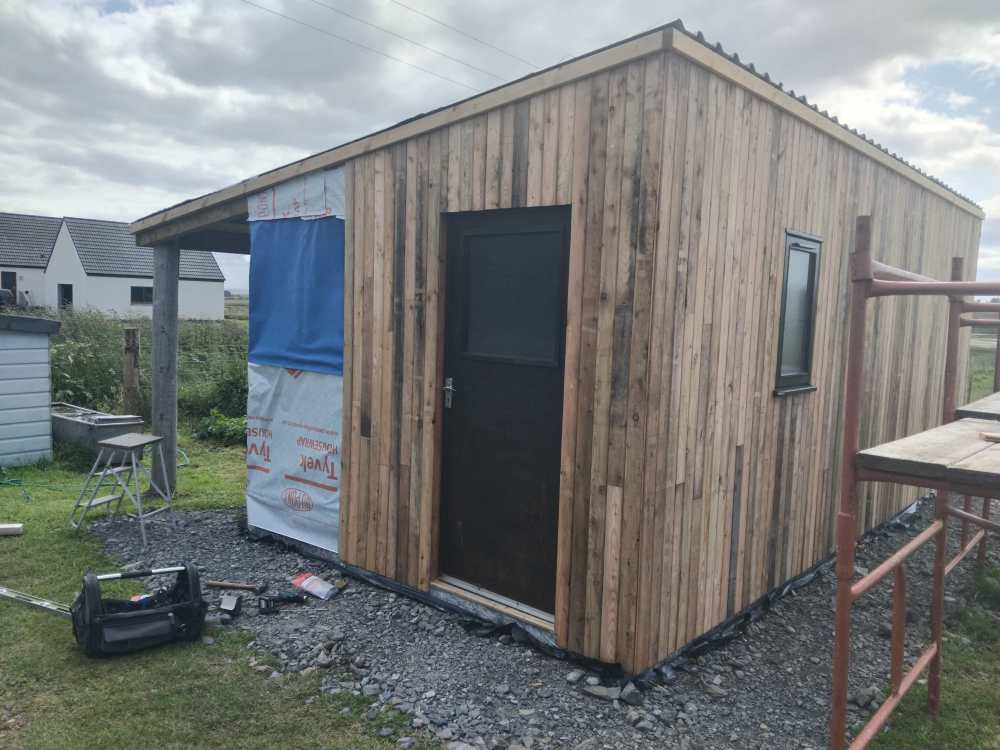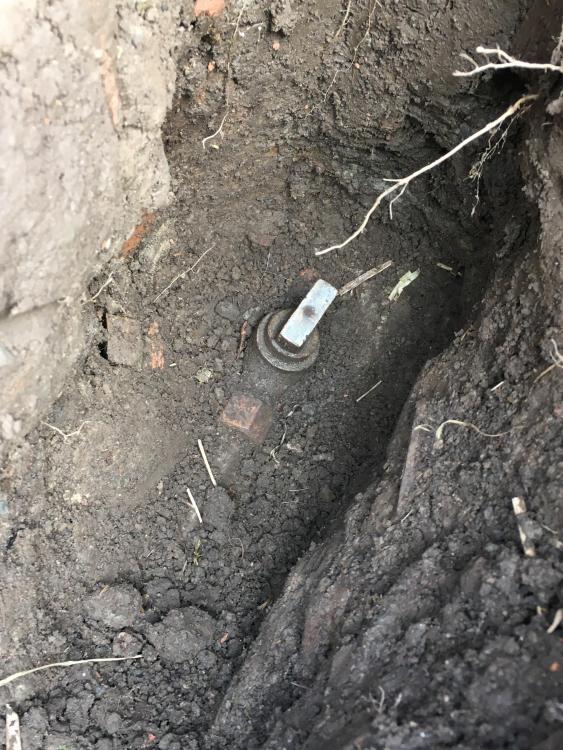
AndrewR
Members-
Posts
33 -
Joined
-
Last visited
Personal Information
-
About Me
Going Off-grid - Escaping the urban sprawl of what was once God's own country (Yorkshire)
-
Location
Scotland, North East Coast
Recent Profile Visitors
The recent visitors block is disabled and is not being shown to other users.
AndrewR's Achievements

Member (3/5)
2
Reputation
-
This post was interesting, but can someone advise on waterproofing please? I don't care about the aesthetics of colour change from brown to silver. I live on the far north coast of Scotland - often high winds, lashing rain, and salty misty air. I have used Scottish larch cladding a lot (I bought a job lot) for various applications, the most recent being a shed that I built (photo attached: during construction). The larch on the shed is currently untreated. What I am finding is that when it rains, water tracks down to the base of the planks and the cladding remains saturated at the bottom six inches for a long time. I also found this on other places where I used the larch. This in itself I want to remedy, but it also then tends to blacken at the base due to the water and, I assume, fungus. In short, I am looking for a larch cladding waterproofing treatment. Which products can anyone recommend? On other applications I have tried raw linseed oil, and it is okay for a month or so, but when the wet season starts if seems as it I hadn't used anything. I thought about yacht varnish, but I'm finding mixed information, i.e. it is good, it can lead to trapped moisture, it is not good for softwood, products now are not as good as they used to be Thanks, Andrew
-
I'm restoring an old cottage in Scotland. It is off grid. We've been living in a caravan on site for a few years and have an off-grid solar PV system with DC but also a small inverter for 240V. I'm just wiring up the cottage now, in readiness for moving the electrics over. I've done the DC, but I would like some advice please on the regulations regarding the siting of a domestic 240V fuse box or breaker. We have 240V 13A sockets in the caravan and will have them in the cottage. Their power will come through an MCB near the battery, then via an inverter. All there will be in the cottage is one ring circuit of 240V. I would like to know please whether there needs to be a separate breaker in the cottage. Specifically, what do wiring regulations say about siting of fuses? Can they be external or must they be inside the dwelling? Thanks, Andrew
-
Slate covering on freestanding pent roof?
AndrewR replied to AndrewR's topic in Roofing, Tiling & Slating
Thanks, I've looked at the mono-pitch ridge tiles. As with my reply to Peter, how are these affixed to the fascia board? They'll be cemented to the tiles on the roof, but will I have to drill holes in them to screw them to the fascia? Andrew -
Slate covering on freestanding pent roof?
AndrewR replied to AndrewR's topic in Roofing, Tiling & Slating
Thanks Peter, The back edge is not abutting a wall - the structure is free standing. To use a strip of lead on the top edge as you describe, how would the lead be fixed? Would it be nailed to the fascia? -
Can someone please give advice to an amateur roofer? I want to put a slate covering on a free-standing mono-pitch pent roof over a wood store. I want to use slate because I want it to be in keeping with the roof of an adjacent Victorian cottage but I also want to practice my slating on a small area. I've never seen any pictures of a slate covering on a pent shed roof. What I can't figure out is how (whether it is possible?) to protect the top of what would be the 'ridge'. There won't be a ridge of course, and so no ridge tiles to protect the top slates from wind lift and water ingress. I thought about using clay ridge tiles and laying them on their side, with one side vertical, drilled and screwed to the fascia board, but this might look silly. If it can't be done I'm thinking about making in asymmetric ridged roof with a very short pitch on one side to allow me to have a proper ridge. Any advice would be appreciated, thanks. Andrew
-
Which Circular Saw (blade?) to cut with the grain
AndrewR replied to AndrewR's topic in General Joinery
Thanks for all the helpful advice. I should have mentioned, I'm off-grid, and I've only got a 500W inverter. So, a high power table saw is not an option. That is why I was looking at the Makitas as I can charge their Li-on batteries with my system. Andrew -
I'm looking to buy my first circular saw. Can someone advise a non-joiner please? I want the saw because I'm building a picket fence, and due to the shortage of timber I couldn't get any 3" wide pales. So, I bought some 150mm x 4800mm planks and intend to cut them down the length of the plank. From my understanding, I need a rip saw blade. I've looked at Makita cordless tools but I can't find specifications on the blades that they come with. I've also searched Screwfix and the only rip saw blades that they have are described as "coarse ripping and cross cut": https://www.screwfix.com/c/tools/circular-saw-blades/cat5990012#category=cat5990012&suitablecuttingapplication=wood&typeofcut=coarse_ripping___cross_cut So, I don't know whether these Screwfix blades are the right thing for the job. Am I just not looking in the right place? Is there a special rip saw blade for circular saws? Thanks for any advice. Andrew
-
Thanks for the replies, Okay, my architect put plans in and after a bit of liaison between he and the respective departments, I was granted approval by Planning and Building Regulations to go ahead with the restoration (it is a change of use). So, the respondents on here are saying (with regard to Building Regulations) that I now 'have a Building Warrant'. Okay. What I meant, and initially said, was the completion certificate that complies with everything in the Building Regs., i.e. something that is given to me at the end of the build after it has been inspected. Can someone tell me whether this...finalisation document... is required to get VAT refunded at the end of the build? On the refund form does one have to submit it to get the refund? A bit more background: I will comply with all the planning requirements, but not the requirement of building regulations. I am aware that I may not be able to sell the house afterwards. I don't care about this. I understand that I can request an amendment, but isn't there a fee to pay for this? Some of the things that the architect proposed are impossible to attain, due to the internal dimension of the building, hence my question. Andrew
-
When claiming back the VAT (on my Scottish DIY build), can someone tell me whether the Building Warrant is needed before the Tax Office will issue the money? Question 16 on the form asks about the Building Regulations Completion Certificate, but it gives a "yes" or "no" option, and goes on to say that if it isn't provided then 'what will I be providing instead?'. It is possible that I will not get a Building Warrant because some of the architect's specifications are impossible to meet and/or impractical. Thanks, Andrew
-
Is there a plumber (in Scotland) who can give me some advice please? In my field there is an animal's drinking trough with a fill level which is maintained by a ballcock. I want to turn off the water supply to this trough. I have found what I believe to be the stop tap, adjacent to the trough, but it is not like anything that I have ever seen before (photograph attached). This 'stop tap' was 1ft below ground at the base of a vertical piece of clay pipe with an access cover, thus I assume that it must be the stop top. I can't turn it however, so I've cleaned it up and soaked it in plusgas. I'll try again at it tomorrow. Is this type of stop tap familiar to anyone and if so how easy is it to free? The top section appears to be all one solid piece of brass with screw threads fixing this to the pipe base. Is this the way to turn the valve, by rotating all the whole top section in its thread? Advice appreciated.
-
I am making an application for a new mains potable water connection with Scottish Water. It is for a small one bedroom cottage. Scottish Water are asking me whether I want a "connection size of 25mm or 32mm or higher". They go on to say (typically) "if you are unsure, ask your contractor". Now, apart from the question of "which contractor?" - groundworker maybe? Can someone tell me the pros and cons of choosing one size over the other? Is there perhaps an extra cost (to their already ridiculous fee of £1200 mostly for the administration work involved) to choosing the larger bore? I assume that the smaller diameter will increase tap outlet velocity, or will it reduce reduce tap pressure? Thanks, Andrew
-
On the VAT Refunds for DIY Conversions form (https://assets.publishing.service.gov.uk/government/uploads/system/uploads/attachment_data/file/828048/VAT431C_form_and_notes__1_.pdf) it states on page 16 that solar panels incorporated into the building can be claimed for, if you are a DIY builder. Therefore on goods I purchase and install they are eligible. Are you saying therefore that the supplier has to charge VAT at 20% and I claim 15% of this back (since the project is reduce rated at 5%)? What confuses me is when the claim form guidance states that VAT must by applied by the seller at the correct rate otherwise it cannot be reclaimed: https://www.gov.uk/vat-building-new-home/how-to-claim Andrew



